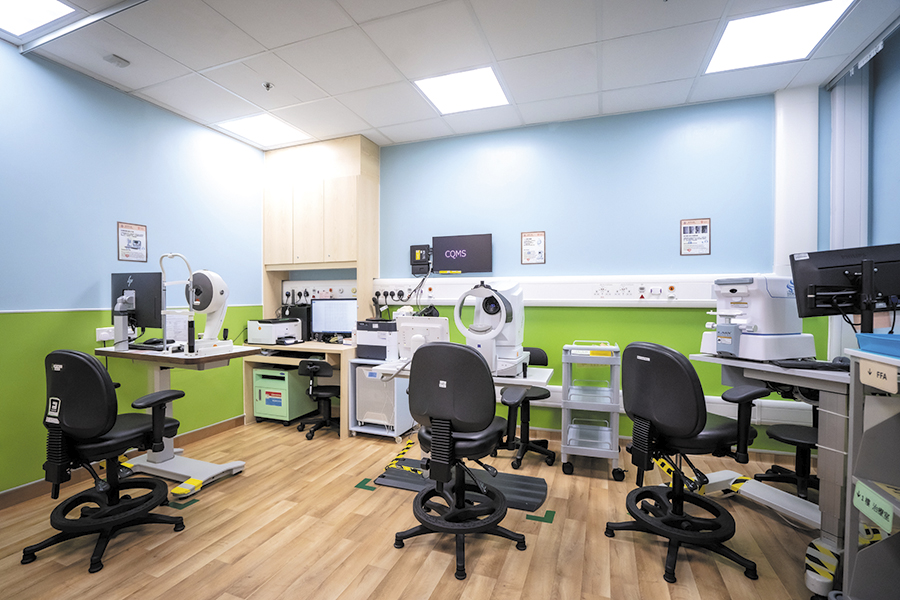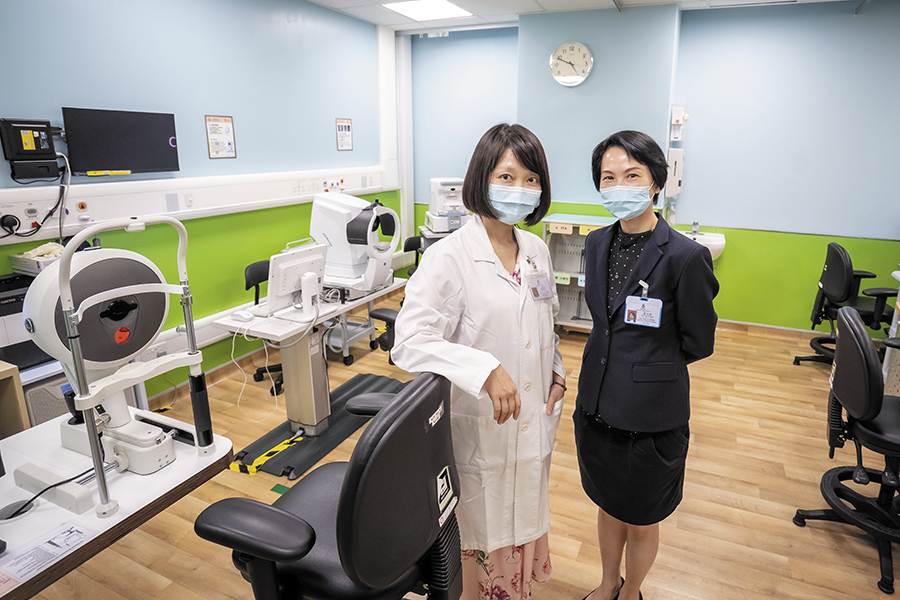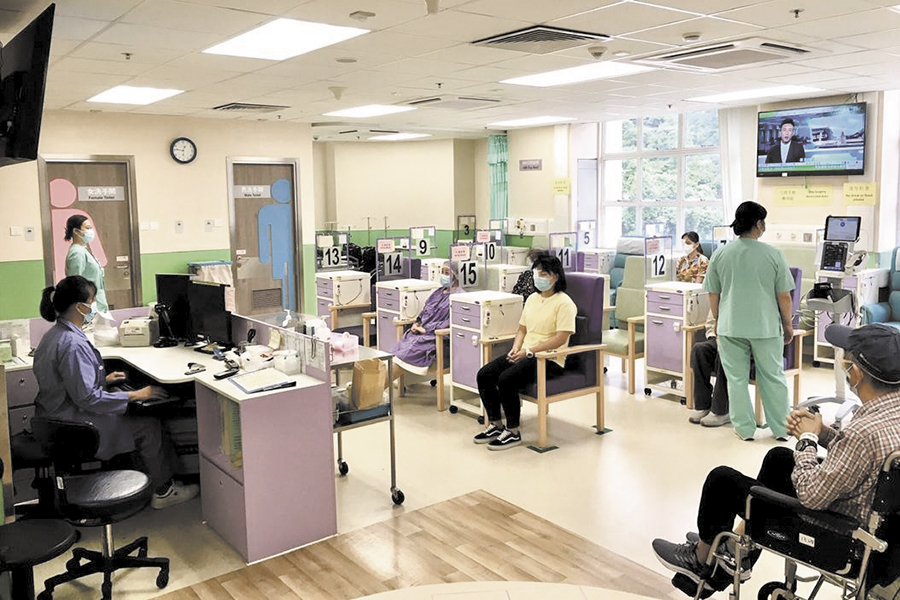Eye treatments streamlined to minimise repeat visits of patients
Ophthalmology services at Tung Wah Eastern Hospital (TWEH) and Pamela Youde Nethersole Eastern Hospital (PYNEH) of Hong Kong East Cluster (HKEC) have been streamlined and repositioned in response to the rapidly ageing population which pushes the demand for eye services higher in the district.
 Under the reorganisation carried out in the third quarter of 2021, the Department of Ophthalmology of TWEH has been turned into a day centre providing general eye examinations and day surgery, including surgeries suitable to be performed under local anaesthesia, such as glaucoma, intravitreal injections, cataract surgeries, posterior segment surgeries, etc. Patients can go home the same day after treatment. PYNEH meanwhile specialises in more complex treatment requiring general anaesthesia and inpatient services. Dr Callie Ko, Chief of Service (Ophthalmology) of HKEC says the reorganisation has shortened the waiting times for examination and surgery for different patients’ need and enhancing the quality of service.
Under the reorganisation carried out in the third quarter of 2021, the Department of Ophthalmology of TWEH has been turned into a day centre providing general eye examinations and day surgery, including surgeries suitable to be performed under local anaesthesia, such as glaucoma, intravitreal injections, cataract surgeries, posterior segment surgeries, etc. Patients can go home the same day after treatment. PYNEH meanwhile specialises in more complex treatment requiring general anaesthesia and inpatient services. Dr Callie Ko, Chief of Service (Ophthalmology) of HKEC says the reorganisation has shortened the waiting times for examination and surgery for different patients’ need and enhancing the quality of service.
 TWEH has upgraded its services of pharmacy department, medical records office, and shroff to cope with the increased volume of ophthalmology day service. A rapid dispensing service has been set up by the pharmacy department to speed up the processing of prescriptions with single component, thus shortening the waiting time for patients. PYNEH has meanwhile enhanced its ophthalmology ward and operating theatre support to meet the needs of inpatients and surgical procedures.
TWEH has upgraded its services of pharmacy department, medical records office, and shroff to cope with the increased volume of ophthalmology day service. A rapid dispensing service has been set up by the pharmacy department to speed up the processing of prescriptions with single component, thus shortening the waiting time for patients. PYNEH has meanwhile enhanced its ophthalmology ward and operating theatre support to meet the needs of inpatients and surgical procedures.
“We are very satisfied with the results,” she remarks. “The two hospitals are of different scales. Hence, the reorganisation is challenging. We are grateful for everyone’s dedication and coordination.” TWEH is working to increase its number of subspecialty clinics, Siu adds, so that each clinic will focus on eye diseases under same type, allowing doctors to focus on their specialties and provide even better treatment for patients.

 Under the reorganisation carried out in the third quarter of 2021, the Department of Ophthalmology of TWEH has been turned into a day centre providing general eye examinations and day surgery, including surgeries suitable to be performed under local anaesthesia, such as glaucoma, intravitreal injections, cataract surgeries, posterior segment surgeries, etc. Patients can go home the same day after treatment. PYNEH meanwhile specialises in more complex treatment requiring general anaesthesia and inpatient services. Dr Callie Ko, Chief of Service (Ophthalmology) of HKEC says the reorganisation has shortened the waiting times for examination and surgery for different patients’ need and enhancing the quality of service.
Under the reorganisation carried out in the third quarter of 2021, the Department of Ophthalmology of TWEH has been turned into a day centre providing general eye examinations and day surgery, including surgeries suitable to be performed under local anaesthesia, such as glaucoma, intravitreal injections, cataract surgeries, posterior segment surgeries, etc. Patients can go home the same day after treatment. PYNEH meanwhile specialises in more complex treatment requiring general anaesthesia and inpatient services. Dr Callie Ko, Chief of Service (Ophthalmology) of HKEC says the reorganisation has shortened the waiting times for examination and surgery for different patients’ need and enhancing the quality of service.
Receiving positive feedbacks from patients and caregivers
For intravitreal injections, for instance, patients used to have to visit the hospital four times for follow-up examinations. Under the reorganised service, patients can complete multiple pre-operative assessments in one day and visit the day centre again on the day of surgery. “The day centre can provide a more convenient and one-stop service for patients and the scheduling of assessments on the same day is also more user-friendly. For patients with severe eye diseases and limited mobility, reducing the number of visits and travel time can significantly improve their quality of life,” Dr Ko explains. “Both patients and caregivers have responded positively to the new arrangement.” The reorganisation has facilitated more effective use of the two hospitals’ resources, Dr Ko adds. TWEH has upgraded its services of pharmacy department, medical records office, and shroff to cope with the increased volume of ophthalmology day service. A rapid dispensing service has been set up by the pharmacy department to speed up the processing of prescriptions with single component, thus shortening the waiting time for patients. PYNEH has meanwhile enhanced its ophthalmology ward and operating theatre support to meet the needs of inpatients and surgical procedures.
TWEH has upgraded its services of pharmacy department, medical records office, and shroff to cope with the increased volume of ophthalmology day service. A rapid dispensing service has been set up by the pharmacy department to speed up the processing of prescriptions with single component, thus shortening the waiting time for patients. PYNEH has meanwhile enhanced its ophthalmology ward and operating theatre support to meet the needs of inpatients and surgical procedures.
Focusing more on subspecialties to optimise treatment
The goal of the reorganisation is to transfer most ophthalmology specialist outpatients from PYNEH to TWEH in phases, with a target of referring 17,000 within three years. Loretta Siu, Department Operations Manager (Ophthalmology) of TWEH says the programme is nearly 75% of the way to its target in the first year, and she is confident the target will be reached ahead of schedule.“We are very satisfied with the results,” she remarks. “The two hospitals are of different scales. Hence, the reorganisation is challenging. We are grateful for everyone’s dedication and coordination.” TWEH is working to increase its number of subspecialty clinics, Siu adds, so that each clinic will focus on eye diseases under same type, allowing doctors to focus on their specialties and provide even better treatment for patients.
